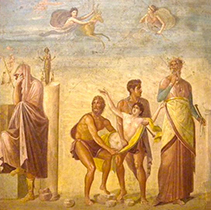 1
1Ancient theatre scenery and Roman wall-painting - the material evidence
Given the extensive amount of literature that argues for a connection between ancient stage scenery and Romano-Campanian wall-painting, it is surprising to note that the material evidence in terms of domestic wall-paintings thought to depict stage scenery is relatively small. In addition to being relatively small in number, depending on whose definition you use, they also vary in terms of their compositional elements. Having said that it is possible to locate them within two groups - stage sets including figures thought to be actors' performing identifiable plays and actorless depictions of stage scenery.
Depictions of actors and staged playsThe most cited examples of actors performing on stage sets are relatively small in size and therefore appear picture-like as opposed to the large-scale wall-paintings associated with the actorless group. Within the former group one has to make a distinction between figures thought to represent actors performing on stages and the depiction of figures associated with ancient myths, poetic narratives or dramatised myths. For example, it is often unclear whether or not wall-paintings such as the Sacrifice of Iphegenia in Casa del Poeta Tragico and Casa di Menandro, are directly based on the myth itself or the dramatised version, because neither contain references to the stage or stage scenery (fig.1&2). Conversely, the Iphigenia in Tauris wall-painting discovered in Casa dei Pinarius Cerialis appears to replicate events described in Euripides' dramatised version, set within the context of a theatrical mise-en-scène (fig.3). The same may be true of a wall-painting found in Casa di Apollo (fig.4). Both wall-paintings contain architectural elements such as multiple doors, tiered colonnades and niches containing sculptures, similar to those found in many Roman theatres (fig.5).
There are also a few examples of vignettes within larger wall-paintings that are thought to depict so called permanent scaenae frons stage sets. An example of this type of depiction was found in the Nero's Golden Palace (Domus Aurea). Given the fact that in the first century AD permanent Roman theatres existed in many cities it is perhaps more surprising to note the relatively small number of paintings depicting staged scenes, as opposed to the ubiquitous number of paintings depicting mythological scenes that contain no reference to theatrical mise-en-scène.
 1
1
|